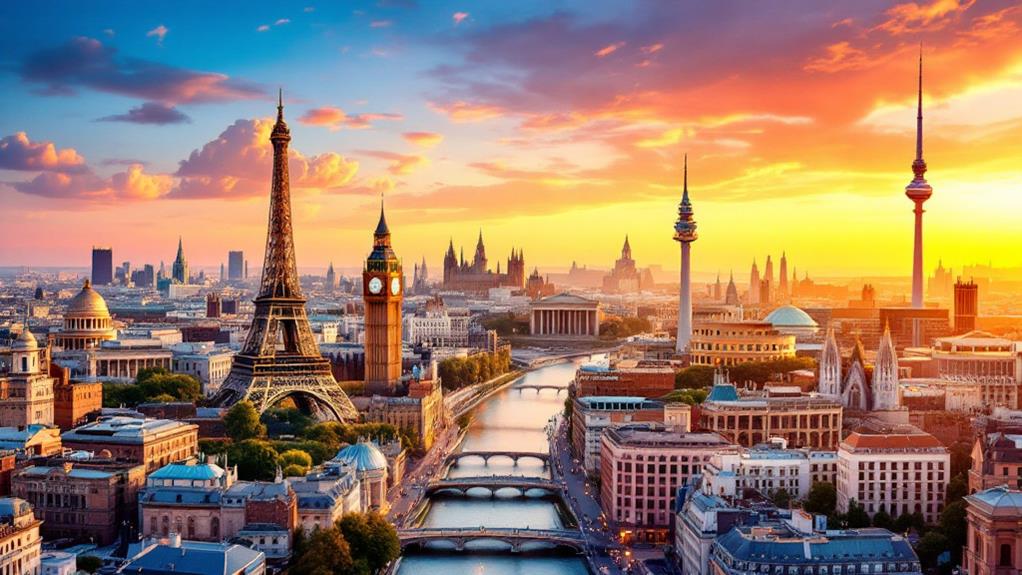Top 10 Largest Cities in the World by Population

If you're curious about the world's largest cities by population, here's what you need to know. Tokyo leads with over 37 million people, not far behind is New Delhi with around 33.8 million. Shanghai boasts nearly 30 million residents, followed by Dhaka and Cairo with populations exceeding 23 million. São Paulo, Beijing, and Mexico City each have over 21 million inhabitants. Mumbai closely matches these figures, while Osaka rounds out the top ten with around 19.3 million. Each city presents unique challenges and opportunities shaped by their sheer size, offering a deeper look into global urban life if you investigate further.
Tokyo, Japan
Investigating Tokyo, Japan, reveals why it's the most populous city in the world, boasting 37,115,035 residents in 2024. As you navigate through this lively metropolis, you'll notice how its vast population defines the city's character and energy. Despite a slight population dip of -0.21% from the previous year, Tokyo remains a dynamic hub that draws people from all over the globe. The metropolitan area of Tokyo not only serves as the heart of the nation but also accounts for about 30% of Japan's total population, underlining its essential role in the region.
Tokyo's urban infrastructure supports this immense population with an advanced public transportation system, seamlessly accommodating millions daily. It's evident that the city's ability to manage such a high population density is key to its status as the most populous city. As you investigate, you'll find that Tokyo is not just a city of numbers but a lively economic and cultural center. Its influence on Japan's GDP is significant, making it not only a populous city but a crucial one. The metropolitan area is a reflection of Tokyo's blend of tradition and modernity, thriving amidst its vast population.
New Delhi, India
New Delhi captivates with its lively energy and staggering population of approximately 33,807,403 residents in 2024, making it the second largest city in the world by population. As the capital of India, it's not just a city but a symbol of the country's dynamic growth and cultural richness. New Delhi's rapid urbanization is evident in its impressive population increase of 2.63% from the previous year, driven by migration and urban expansion.
This thriving metropolis plays an essential role as India's political, cultural, and economic hub, attracting people from all over the nation and beyond. The city's unique blend of history and modernity offers endless opportunities but also presents challenges. As part of the larger National Capital Territory of Delhi, which includes both urban and suburban areas, New Delhi faces increasing population density. This growth strains infrastructure and urban planning efforts, demanding creative solutions to maintain the city's livability.
In New Delhi, you'll witness a convergence of tradition and creativity, as it emerges as a center for education and technological advancements. The city's vibrancy and resilience make it a fascinating place, constantly evolving amidst the pressures of rapid urbanization.
Shanghai, China
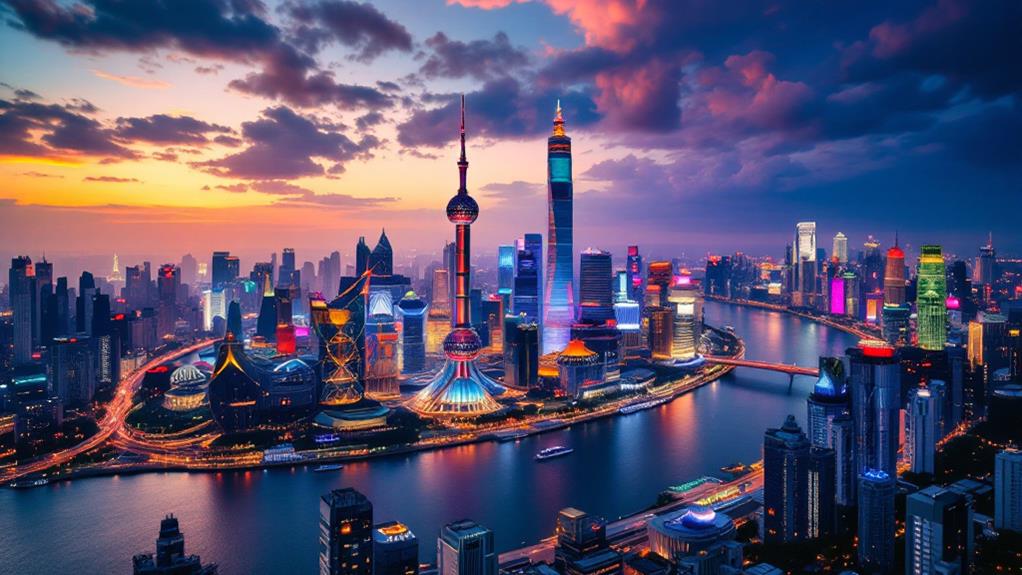
With its vibrant energy and impressive scale, Shanghai stands as the third most populous city in the world in 2024, boasting a population of 29,867,918. This lively metropolitan area reflects a growth rate of 2.25% from the previous year, showcasing Shanghai's role as a major global financial hub. You're stepping into a city that contributes greatly to China's economy, with a skyline that features the iconic Oriental Pearl Tower and the towering Shanghai Tower, one of the tallest buildings worldwide.
Navigating Shanghai, you'll find a highly developed infrastructure that includes the world's largest metro network, making it easier to move through this urban sprawl. Urbanization in Shanghai has progressed rapidly, leading to challenges you might notice, like housing shortages and environmental concerns. These issues are being addressed through initiatives focused on sustainable urban development, a crucial step for the city's future.
In Shanghai, you're not just witnessing a growing population; you're seeing a city evolving to meet the demands of modern life while balancing its rapid expansion with creative solutions. It's a place where tradition meets cutting-edge progress, reflecting the dynamism of contemporary urban living.
São Paulo, Brazil
São Paulo, Brazil, stands as a lively metropolis, ranking fifth globally by population with approximately 22,806,704 residents in 2024. As the largest city in Brazil, São Paulo is a thriving metropolitan area that serves as a crucial economic and cultural hub in South America. Its diverse population reflects a rich tapestry of cultures and ethnicities, owing much to its history of immigration.
In São Paulo, you'll find a city that greatly contributes to Brazil's GDP, housing key financial institutions like the São Paulo Stock Exchange. The city also welcomes the arts, with landmarks such as the São Paulo Museum of Art enriching its cultural landscape. However, the urban density presents challenges, including notorious traffic congestion, housing shortages, and pressing environmental concerns. These issues require creative urban planning and sustainable solutions to manage the city's rapid growth and maintain its status as a leading metropolitan center.
The dynamic spirit of São Paulo is evident in its lively neighborhoods and busy streets. Regardless of your exploration of its cultural institutions or traversing its economic corridors, this largest city in Brazil offers a unique blend of challenges and opportunities, making it a vital part of the global urban tapestry.
Mexico City, Mexico
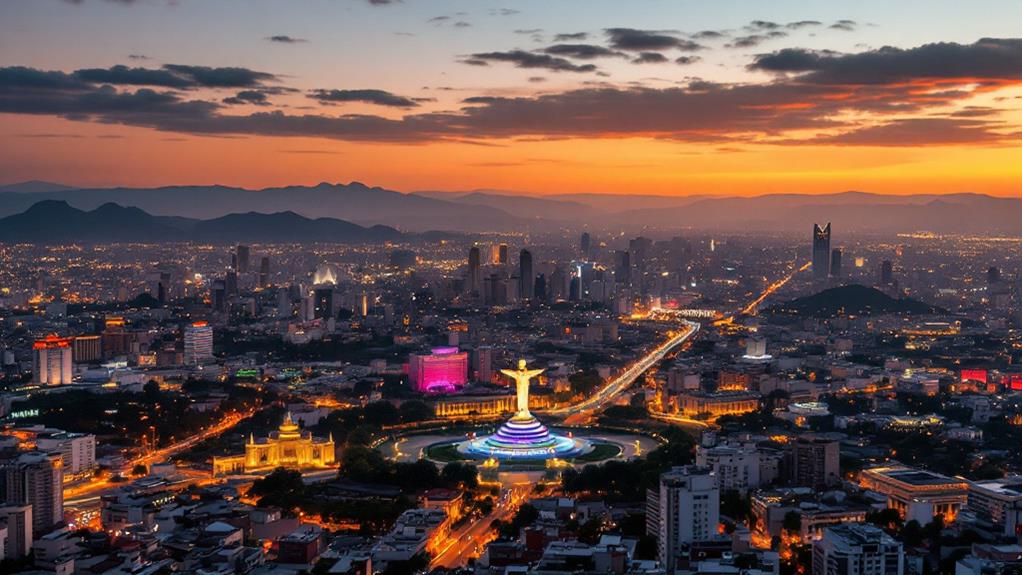
Leaving behind the hectic streets of São Paulo, we arrive in Mexico City, another of the world's most populous urban areas. As one of the largest cities globally, Mexico City boasts a staggering population of approximately 21,700,000 residents as of 2024. Serving as the capital of Mexico, this lively metropolitan area is a significant cultural, political, and economic hub in Latin America.
At an elevation of about 2,240 meters (7,350 feet) above sea level, the city's unique geography influences its climate and air quality. You'll notice that its high elevation can lead to cooler temperatures but also contributes to challenges like pollution. Infrastructure strain, traffic congestion, and population density further complicate urban life here.
Despite these challenges, Mexico City offers a rich tapestry of history and culture. You can investigate numerous UNESCO World Heritage Sites, including the colorful historic center. Nearby, the ancient Aztec site of Teotihuacan beckons you to probe into the past. Regardless of whether you're traversing through its modern metropolitan area or immersing yourself in its historical sites, Mexico City reveals why it remains one of the largest and most fascinating cities in the world.
Cairo, Egypt
Cairo, Egypt, stands as a metropolis of immense proportions, with an estimated population of 22,623,874 in 2024, solidifying its place among the world's largest cities. As the capital of Egypt, Cairo's sheer size and continuous growth, marked by a 1.99% increase, make it a crucial player in the urban landscape. This lively city isn't just big; it's a dynamic cultural, political, and economic hub in the Arab world, drawing people from across the globe to its historic and modern marvels.
When you investigate Cairo, you'll encounter a fascinating blend of the old and new. The urban area showcases ancient sites like the iconic Pyramids of Giza alongside contemporary infrastructures. This mix is part of what makes Cairo such a compelling destination for tourists and residents alike. However, living in one of the world's largest cities comes with its challenges. You'll notice overcrowding and transportation congestion as significant issues, a common side-effect of rapid urbanization. Environmental concerns are also on the rise, prompting discussions on sustainable solutions for the urban area. Despite these challenges, Cairo remains a city of great allure and unyielding energy.
Dhaka, Bangladesh
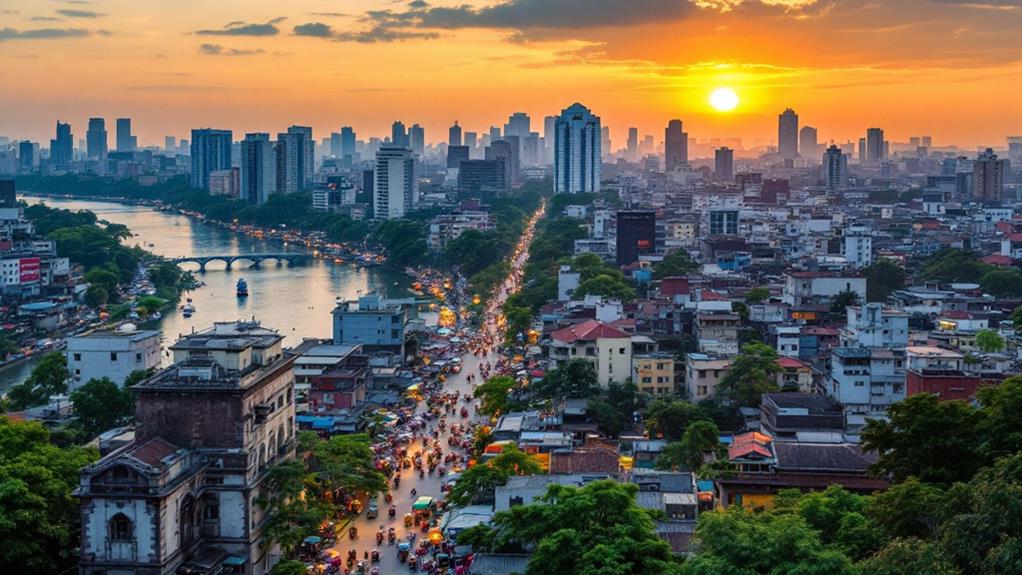
As you investigate the lively metropolises of the world, your expedition takes you to Dhaka, Bangladesh, a city whose estimated population will reach around 23,935,652 in 2024. Dhaka is renowned for being one of the most densely populated cities on the planet. This thriving capital of Bangladesh stands as the nation's economic, political, and cultural hub, playing a crucial role in its development.
The rapid pace of urbanization in Dhaka reflects a broader trend across Asia, with significant urban migration contributing to its swift population growth. A growth rate of 3.13% from the previous year underscores the city's dynamic expansion. But with this boom comes challenges. Dhaka's infrastructure grapples under the strain of such rapid growth, leading to pressing issues like housing shortages and environmental concerns.
These challenges highlight the complexity of balancing population growth with sustainable urban development. As you investigate Dhaka, you witness firsthand the lively energy that defines this city, despite its hurdles. The United Nations projects continued increases in urban populations across the region, and Dhaka's transformation serves as a proof of the ongoing evolution of urban landscapes in Bangladesh and beyond.
Mumbai, India
In 2024, Mumbai, India, stands as one of the world's largest cities with a population of approximately 21,673,149. This lively metropolis exemplifies rapid urbanization, drawing people from all over the country. As the financial capital of India, Mumbai houses the Bombay Stock Exchange and numerous multinational corporations, making it an economic powerhouse.
Mumbai's colorful and diverse economy is a key contributor to its growth. You'll find that the city thrives in several sectors:
- Finance: As the financial capital, it's home to leading banks and financial institutions, driving economic activity.
- Entertainment: Bollywood, the heart of India's film industry, produces countless films annually, attracting talent nationwide.
- Fashion: Mumbai is a trendsetter, influencing styles across the country with its dynamic fashion scene.
- Information Technology: With numerous IT companies, the city is a hub for innovation and tech development.
However, the city's urban landscape presents challenges. A mix of modern skyscrapers, historic buildings, and informal settlements highlights the complexities of urban development and infrastructure. Maneuvering through Mumbai can be both exhilarating and overwhelming, but it's undeniably a city where opportunity abounds amidst the hustle and commotion of one of the largest cities by population.
Beijing, China
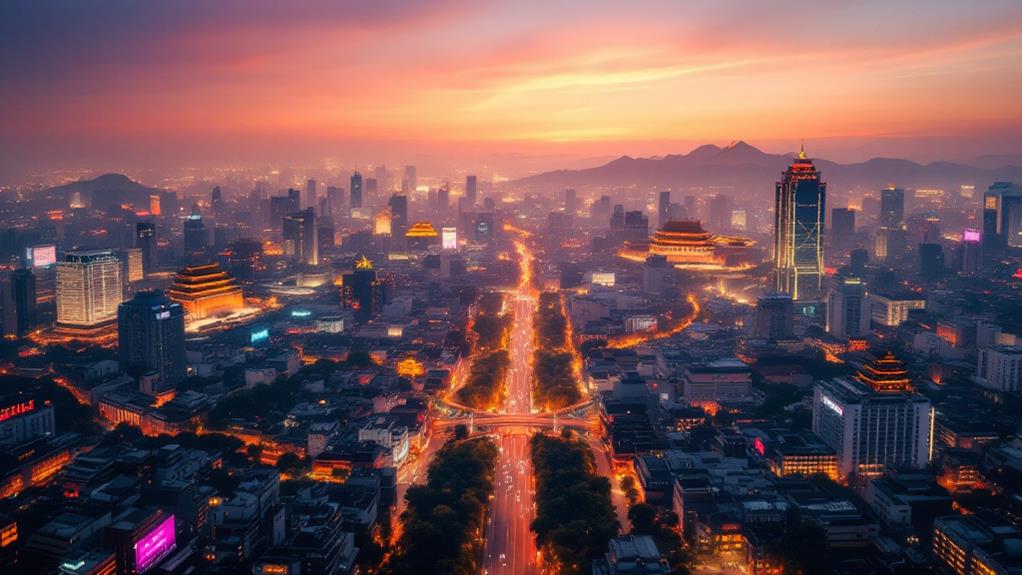
Often lively with life, Beijing, China's capital, is a city that never sleeps, boasting a population of approximately 22,189,082 residents as of 2024. As one of the largest cities by population, Beijing thrives with energy and influence, playing an essential role in China's cultural, political, and educational landscape. It's not just the sheer number of people that makes Beijing significant, but also its vast expanse, covering about 16,410.54 square kilometers, ranking it amongst the largest municipalities worldwide.
In Beijing, history comes alive as you investigate its iconic sites like the Forbidden City and the Great Wall of China. These landmarks not only draw millions of tourists but also echo the city's rich heritage. However, living in such a populous city comes with challenges. Rapid urbanization has led to issues like air pollution and traffic congestion, making sustainable urban development a priority for the future.
Despite these challenges, Beijing's growth rate of 1.94% from the previous year highlights its dynamism and resilience. As you navigate this vibrant metropolis, you'll feel the pulse of a city that balances its historical essence with modern ambitions.
Osaka, Japan
Boasting a population of approximately 19.3 million residents as of 2024, Osaka stands as one of the largest cities in the world. Situated in the Kansai region of Japan, Osaka's impressive population in the world ranks it among the foremost metropolitan regions. As a major economic hub, the city thrives with a lively culture, renowned culinary scene, and significant historical landmarks. Its urban landscape offers a fascinating blend of modern skyscrapers and traditional architecture, creating a unique backdrop for residents and visitors alike.
Osaka's metropolitan significance is further improved by its connections to nearby cities such as Kyoto and Kobe. These connections facilitate a flow of commerce and culture, contributing to Osaka's growth as a commercial center. The city's economy primarily focuses on trade, manufacturing, and tourism, driving its expansion and development. Here are some key aspects of Osaka's global standing:
- Economic Powerhouse: A central player in Japan's economy, with strong trade and manufacturing sectors.
- Cultural Hub: Famous for its food, festivals, and entertainment options.
- Well-connected: Links to major cities like Kyoto and Kobe.
- Diverse Architecture: A mix of modern and historical structures.
Osaka, as one of the world's largest cities, continues to captivate with its dynamism and charm.
